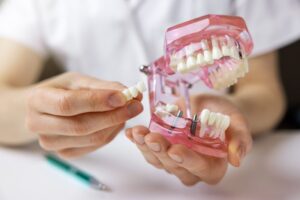
You’re ready to fill in the gaps in your teeth and restore your smile, but with so many options to choose from, it can be difficult to know what’s best for you. Maybe you’ve read about partial dentures and dental bridges but still aren’t sure what to do. Luckily, you’ve come to the right place! In this guide, we’ll break down the differences in each treatment and help you decide which method better suits your needs.
What is a Partial Denture?
A partial denture helps to replace several teeth in a row, though they don’t need to be in consecutive order. Partials don’t fill up an entire upper or lower arch of your mouth like a full denture does. It is a detachable set of artificial teeth that is fixed to a gum-colored base and can be easily removed.
Not only do they create a cosmetic appeal for those with missing teeth, but partial dentures also help accomplish everyday needs like eating and speaking.
What is a Dental Bridge?
Like a denture, the goal of a bridge is to restore your smile and oral functionality, but it accomplishes this purpose a little differently.
Instead of a removable device that attaches to a plate, a bridge is fixed in place by healthy teeth on either side of the gap that are topped off with crowns to support the prosthesis. As a result, these pillars create a very stable, secure fit for the artificial teeth to “bridge the gap.”
Pros & Cons of Partial Dentures
There are several upsides when it comes to having partial dentures:
- They can be fitted regardless of the condition of the surrounding teeth and gums.
- Partials are easily removable for cleaning.
- Partial dentures are one of the most affordable tooth replacement options on the market.
However, some downsides come with this treatment:
- Durability: Partial dentures generally don’t last as long as dental bridges or other tooth replacements.
- Poorly fitting partial dentures may cause discomfort and need to be periodically checked and adjusted by your dentist or denturist.
- Their removability may prove a hassle for people who don’t want the fuss of taking them out to clean and soak them overnight.
Pros & Cons of Dental Bridges
There are some wonderful advantages that dental bridges can provide:
- They’re long-lasting, with an average lifespan of 10-15 years.
- Dental bridges look and feel more natural than partial dentures.
- Unlike their detachable counterparts, dental bridges remain fixed in your mouth 24/7 and can be brushed and flossed just like natural teeth.
You may find some factors of bridge treatment unappealing, including:
- The teeth surrounding a bridge need to be healthy. This might necessitate preliminary treatment before you can have a bridge installed.
- Your dentist will need to grind down or reshape the abutting teeth to accommodate the bridge.
- Since they are a more permanent solution, bridges typically cost more, depending on the type of bridge, materials used, and the number of teeth being replaced.
The choice is yours and depends on your needs when it comes to choosing between bridges and partial dentures. Consult your dentist for professional assistance in making your choice.
About the Author
Dr. Molly Burton is a 2013 graduate of the University of Louisville. She has dedicated herself to continuing her education to stay current with the latest trends and technologies, including being a member of a local Spear Study club. Interested in a dental bridge to beautify your smile and improve your oral health? Contact Dr. Burton and her team at Magnolia Family Dentistry of Austin online or at their office at (512) 441-2098.
